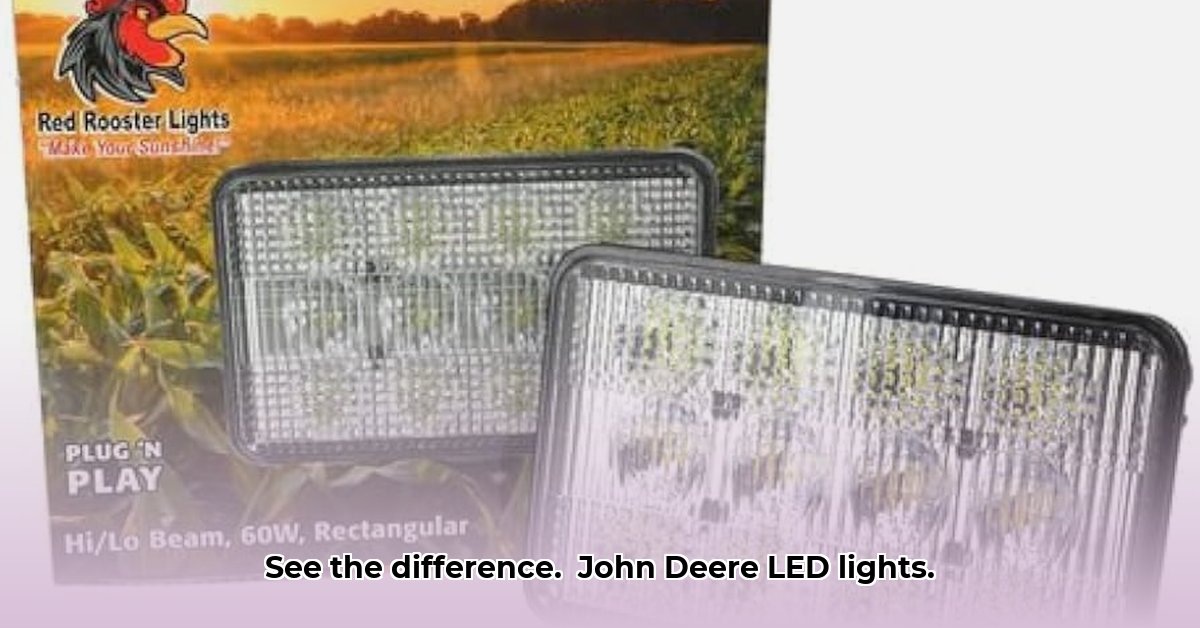
John Deere LED Tractor Lights: A Comparative Review for Enhanced Farm Efficiency
Farming often extends beyond daylight hours. Effective lighting is paramount for both safety and productivity. This review examines John Deere's LED tractor lighting kits, comparing various models and even some Case-IH options, to help farmers and dealers make informed purchasing decisions. We’ll analyze key features, weigh pros and cons, and guide you toward choosing the ideal lighting solution for your needs. For more information on John Deere events, visit the John Deere Show.
Illumination Specifications: Beyond Lumens
Tractor lights, much like vehicle headlights, require brightness, reliability, and longevity. Lumens (a measure of light output) are crucial – higher lumens equate to better visibility, especially in challenging conditions like fog or dust. However, lumen count isn't the sole determinant. The type and wattage of LED diodes significantly impact performance. Higher-wattage diodes provide brighter beams but might consume more power and have a shorter lifespan than lower-wattage counterparts. The optimal choice balances brightness and longevity.
Below is a comparison of example light kits (note: specifications may vary; always verify with John Deere or your dealer):
| Kit | Tractor Models | Approximate Lumens | Diode Type (Example) | Estimated Price (USD) |
|---|---|---|---|---|
| John Deere Tractor LED Kit A | 8120, 8120T, 9620T | 2800-3900 | Mix of 3-watt and 5-watt LEDs | $300 - $400 |
| John Deere Combine LED Kit B | S550, S650, T660 | 1780-3000 | Mix of 3-watt and 5-watt LEDs | $400 - $600 |
| Case IH Combine LED Kit C | 2144, 2166, 2588 | 960-3650 | Primarily 5-watt LEDs | $350 - $450 |
Prices and specifications are subject to change.
The varied lumen outputs and price points highlight the importance of considering individual needs. Higher-lumen kits might be unnecessary for some applications, while others prioritize the enhanced safety of superior brightness.
Compatibility: Ensuring a Seamless Fit
Before purchasing, confirm compatibility with your specific tractor model. Using incompatible lights can lead to mounting or electrical issues. Consult the manufacturer's compatibility guide or your John Deere dealer to avoid future problems.
Cost-Benefit Analysis: Is the Investment Justified?
The initial investment in new lights is substantial, but the long-term benefits are significant. Extended nighttime operating hours boost productivity. Improved visibility enhances safety, reducing accident risks. Many farmers report that increased operational efficiency offsets the initial cost within a single harvest season. However, the return on investment depends on individual circumstances and usage patterns.
Choosing the Right Lights: A Personalized Approach
Selecting the right John Deere LED tractor lights requires considering your specific tractor model, budget, and working conditions. Do you frequently operate in low-light or foggy situations? The answers to these questions guide your selection. Consult your John Deere dealer for personalized recommendations.
Selecting the Best LED Kit for Your John Deere Combine: Long-Term Cost-Effectiveness
Harvesting doesn't pause for darkness. Upgrading your John Deere combine's lighting is vital, but choosing the right kit requires careful consideration of long-term value.
Lumen Output and Beyond
Higher lumens deliver brighter illumination. While specific lumen figures vary (some manufacturers may not provide exact numbers for marketing reasons), the intensity of illumination is crucial. Consider the size of your combine and the area requiring illumination.
Compatibility: A Critical Factor
Verify compatibility with your specific combine model before purchasing. Mismatched kits lead to installation problems. Look for plug-and-play options for easier setup.
Lifespan: Long-Term Savings
LEDs offer extended lifespans compared to traditional bulbs, reducing replacement costs. However, precise lifespan data (in hours of operation) is often unavailable. Ask your dealer for specifics. A longer lifespan minimizes disruptions and downtime.
Cost-Benefit Analysis: A Comprehensive Approach
A cost-benefit analysis compares the initial investment to increased operational efficiency, factoring in reduced harvesting time, potential yield increases, and the cost of potential grain losses due to poor visibility. Will the enhanced safety and visibility justify the initial expense? How will you measure your return on investment?
Choosing Your Kit: A Step-by-Step Guide
- Assess your needs: How much light is required? Which combine areas need illumination?
- Research options: Compare available lighting kits, considering compatibility with your combine model.
- Obtain pricing: Get price quotes from different dealers for both aftermarket and OEM options to compare costs.
- Determine lifespan: Inquire about the expected lifespan of each system to estimate long-term cost.
- Consider installation: A plug-and-play system simplifies installation and reduces costs.
Key Takeaways:
- Prioritize sufficient lumen output.
- Verify compatibility.
- Compare aftermarket and OEM options.
- Obtain detailed pricing and lifespan data.
- Calculate the total cost of ownership (TCO).